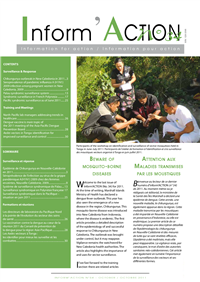Contents
Surveillance & Response
- Chikungunya outbreak in New Caledonia in 2011 – Status report as at 22 August 2011
Armelle Alibert, Anne Pfannstiel and Jean-Paul Grangeon [391 KB] - Seroprevalence of pandemic influenza A (H1N1) 2009 infection among pregnant women in New Caledonia, 2009
Ann-Claire Gourinat, Robert Shaw and Éric D’Ortenzio [72 KB] - Palau syndromic surveillance system
Losii Samsel, Laura McDonald, Boris Pavlin and Jacob Kool
[255 KB] - Syndromic surveillance in French Polynesia
Élise Daudens, Henri-Pierre Mallet and Christelle Lepers [587 KB] - Pacific Syndromic Surveillance as at June 2011
Jacob Kool [303 KB]
Training & Meetings
- North Pacific Lab Managers addressing trends in healthcare
Vasiti Uluiviti [85 KB] - Dengue Vaccine is main topic of the 2011 Meeting of the Asia-Pacific Dengue Prevention Board
Simon Reid and Rangi Fariu [64 KB] - Aedes vectors in Tonga: identification for improved surveillance and control
Laurent Guillaumot, Narendra Singh, Lucien Swillen, Reynold ‘Ofanoa and Noa Tokavou [83 KB]
In Brief
- New WHO staff based in Suva
Welcome back Dr Souarès
A History of Health on Guam edited by Robert L. Haddock
[68 KB]
Editorial
Beware of mosquito-borne diseases
Welcome to the last issue of Inform’ACTION (No. 34) for 2011. At the time of writing, Marshall Islands Ministry of Health has declared a dengue fever outbreak. This year has also seen the emergence of a new disease in the region, Chikungunya. This mosquito-borne disease was introduced into New Caledonia from Indonesia, where the disease is endemic. The first article provides a detailed description of the epidemiology of and successful response to Chikungunya in New Caledonia. The outbreak was brought under control, but it may reappear. Vigilance remains the watchword for New Caledonia health authorities. The article also highlights the importance of and uses for vector surveillance.
If we fast forward to the training section there are related articles on a training programme in Tonga to improve the capacity for mosquito identification, surveillance and control that is a result of collaboration between SPC and the Pasteur Institute of New Caledonia. It is interesting to note that this work has been supported under the banner of ‘natural disaster risk management’, which may become an increasingly important theme in years to come as many agencies move to manage disease outbreaks within a ‘health emergency’ framework. We must continue to be vigilant regarding dengue because the current global epidemic (mostly in Asia) continues unabated and the promise of relief from newly developed vaccines is many years away (refer to the report of the meeting of the Asia-Pacific Dengue Prevention Board).
The surveillance section of Inform’ACTION focuses on the use of syndromic surveillance (SS) in the region. In the two country reports we get a snapshot of different experiences with SS. Palau has only recently established a formal SS system that is neatly and successfully integrated into their existing system via the ‘patient encounter form’. The report from French Polynesia shows how complex a mature system can become and also how effective it is in detecting and monitoring outbreaks of disease. An H1N1 article from the Pasteur Institute of New Caledonia highlights the need to support SS with other forms of data to gain a more complete understanding of the dynamics of disease outbreaks. The final article in this section reflects on the growing utility of the Pacific SS system, which is almost one year old and clearly becoming more useful by the week.
The theme of the 3rd meeting of the Pacific Island Health Officers Association Regional Laboratory Network, ‘creating solutions to today’s problems’, is a fitting way to end this editorial. To me, this is a timely reminder that we need to find a balance between planning for the future (i.e. climate change impacts) and working to solve our current problems.
Finally we warmly welcome Dr Yvan Souarès back to SPC and Dr Eric Nilles to the WHO office in Fiji. We also welcome the publication of the fantastic book A History of Health on Guam by Dr Robert Haddock et al.
So please enjoy this issue of Inform’ACTION.
Dr Simon Reid
Epidemiologist, SPC

